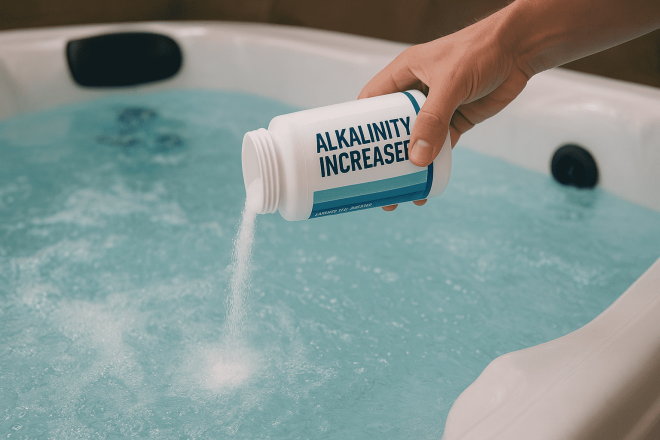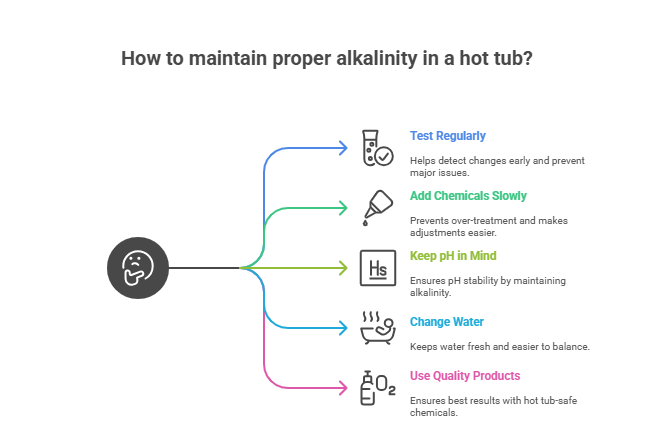
When you own a hot tub, keeping the water clean and balanced is one of the most important parts of maintenance. One key factor in this balance is alkalinity. Alkalinity is basically the measure of how well your water can resist sudden changes in pH. If the alkalinity is too low, the water becomes unstable, and the pH levels can swing up and down quickly. This can cause problems like itchy skin, cloudy water, or even damage to your hot tub’s equipment. On the other hand, if the alkalinity is too high, it can make the water hard to balance and lead to scaling on the surfaces of your spa.
Keeping alkalinity at the right level between 80 and 120 parts per million (ppm) makes sure your hot tub water feels comfortable and safe, while also protecting your investment. The good news is, raising alkalinity is simple. Most of the time, it just takes a common chemical called an alkalinity increaser, which is usually made from sodium bicarbonate (the same ingredient as baking soda).
In this guide, we’ll break down why alkalinity matters, how to test your hot tub water, and the step-by-step process to raise alkalinity safely and effectively.
What Is Alkalinity and Why Does It Matter?
Alkalinity in a hot tub is like a shield that keeps the water steady. It measures how well the water can handle changes in pH, which is the scale that shows if the water is more acidic or more basic. Without enough alkalinity, your hot tub water can get out of balance quickly. That means your pH could suddenly drop (making the water too acidic) or spike (making it too basic).
The ideal range for alkalinity is 80–120 ppm. When alkalinity is in this zone, your water stays steady, and the pH doesn’t bounce around. This balance is important because it:
- Protects your hot tub equipment from corrosion or scaling.
- Keeps the water clearer and more comfortable for soaking.
- Helps prevent skin and eye irritation.
So, think of alkalinity as the foundation of healthy hot tub water. If it’s too low or too high, everything else becomes harder to control.
How to Test Alkalinity in Your Hot Tub
Before you can fix alkalinity, you need to know where it stands. Testing the water is quick and easy. Here’s how you can do it:
Tools you can use:
- Test strips: simple and fast; just dip the strip into the water and compare the colors to the chart.
- Digital testers: more accurate and easier to read; they give you a direct number.
- Liquid test kits: involve adding drops of solution to a water sample; these can be very precise if done carefully.
When to test:
- It’s a good idea to check alkalinity at least once a week.
- Also, test after adding fresh water or using a lot of chemicals, since these can change the balance.
Reading the results:
- Compare your test to the recommended range of 80–120 ppm.
- If the alkalinity is below 80 ppm, it needs to be raised. If it’s above 120 ppm, it may need to be lowered.
- By testing regularly, you can catch problems early and keep your hot tub water balanced and safe.
Step-by-Step Guide to Raising Alkalinity
Now that you know how to test, let’s go through how to raise alkalinity safely and effectively:
Step 1: Test the water
Start by checking your current alkalinity level with one of the methods above.
Step 2: Calculate the amount of increase needed.
Most hot tub guides recommend using an alkalinity increaser made of sodium bicarbonate (baking soda). As a rule of thumb, about 1.5 ounces (42 grams) per 1,000 liters of water raises alkalinity by roughly 10 ppm. Always check your hot tub’s size and follow the instructions on the product.
Step 3: Add it to the hot tub.
Sprinkle the baking soda or alkalinity increaser evenly around the edges of the water. For better results, you can dissolve it in a bucket of water first before pouring it in. Always wear gloves and avoid dumping it all in one spot.
Step 4: Run the jets.
Turn on the jets for 15–30 minutes. This circulates the water and helps the chemical mix evenly.
Step 5: Retest and adjust if needed.
After a few hours, check the water again. If the alkalinity is still below 80 ppm, repeat the process in small amounts until it reaches the right range.
Following these steps will keep your hot tub water balanced, safe, and enjoyable for everyone.
Tips for Maintaining Proper Alkalinity
Keeping alkalinity in balance isn’t just a one-time job it’s something you need to stay on top of to keep your hot tub running smoothly. Here are some tips to make it easier:
- Test regularly: Aim to test your hot tub water at least once a week. This way, you’ll notice any changes before they become big problems.
- Add chemicals slowly: When adjusting alkalinity, always add small amounts at a time and retest. It’s easier to add more than to fix water that’s been over-treated.
- Keep pH in mind: Alkalinity and pH work hand in hand. If alkalinity is low, pH can bounce around. If alkalinity is steady, pH usually stays stable too.
- Change water as needed: Over time, water can become harder to balance because of buildup from chemicals, oils, and other stuff. Draining and refilling your hot tub every 3–4 months helps keep things fresh.
- Use quality products: Stick to hot tub–safe chemicals. Regular baking soda works for small adjustments, but dedicated spa products are designed for the best results.
By following these simple habits, you can make sure your hot tub stays safe, comfortable, and ready to use anytime.

Conclusion
From my own experience working with hot tubs, I can tell you that keeping alkalinity in check makes a huge difference. When your alkalinity is balanced, the water feels softer on your skin, your equipment lasts longer, and you don’t have to constantly fight with pH swings. The process isn’t complicated. Test regularly, add the right amount of baking soda or alkalinity increaser, and give your jets time to circulate everything properly.
If you stay on top of it, you’ll save yourself time, money, and a lot of frustration. Most importantly, you’ll always have clear, comfortable water waiting for you whenever it’s time to relax in your hot tub.
FAQs
1. What is the ideal alkalinity level for a hot tub?
The best range is between 80 and 120 ppm. This helps keep the water balanced and safe to soak in.
2. Can I use regular baking soda to raise alkalinity?
Yes, baking soda works well for small adjustments, but spa-specific alkalinity increasers are often easier to measure and more effective for larger changes.
3. How often should I test my hot tub’s alkalinity?
At least once a week is recommended, but test more often if the water seems off or you’ve added new chemicals.
4. What happens if alkalinity is too low?
Low alkalinity can cause pH to swing up and down, making the water uncomfortable and possibly damaging your hot tub parts.
5. What should I do if I accidentally add too much alkalinity increaser?
Run the jets to circulate and retest the water. If levels are still too high, you may need to partially drain and refill your hot tub to bring things back into balance.
RELATED POST: How Long Will It Take to Paint a Room? Factors, Steps and Expert Advice
GIPHY App Key not set. Please check settings